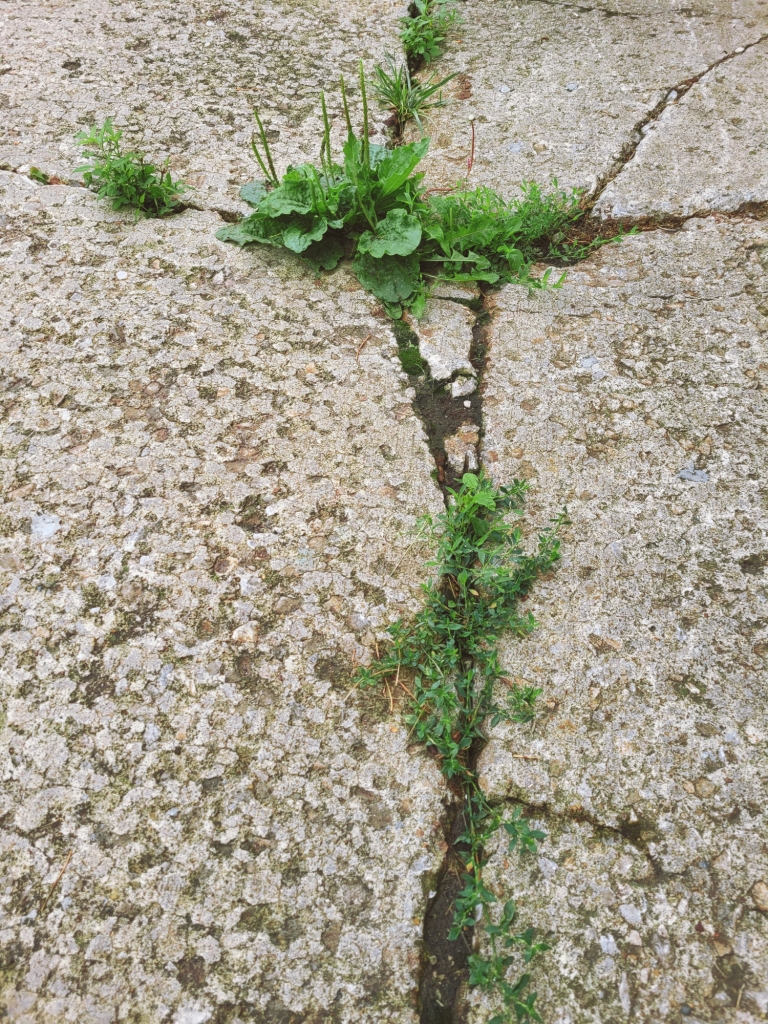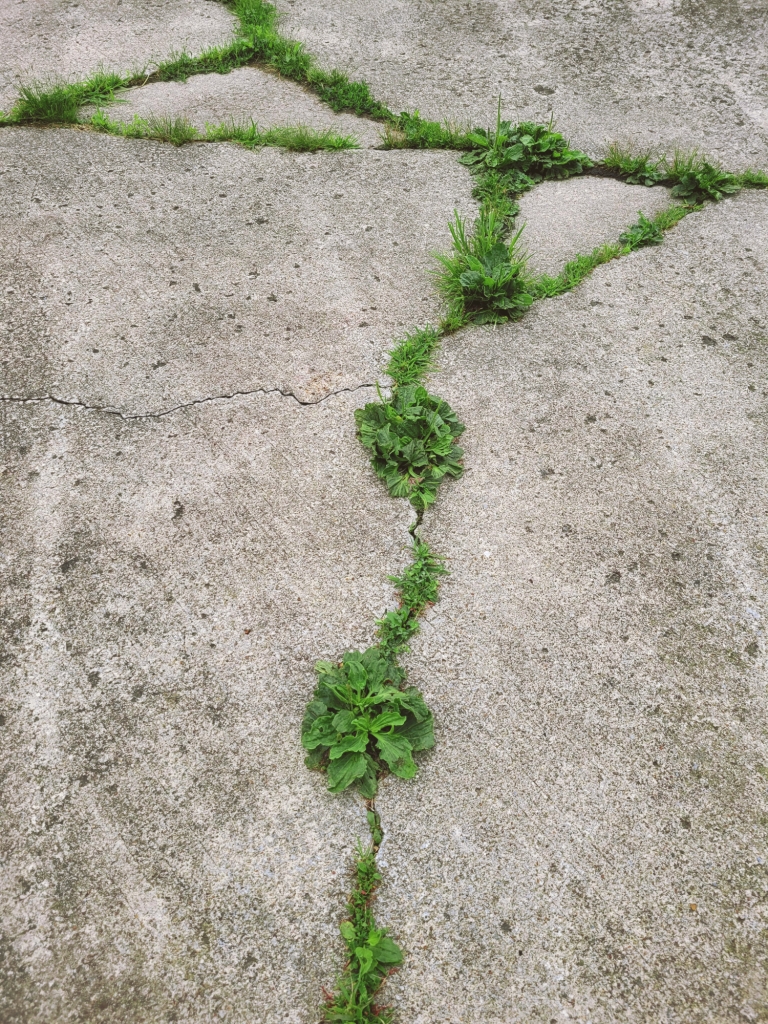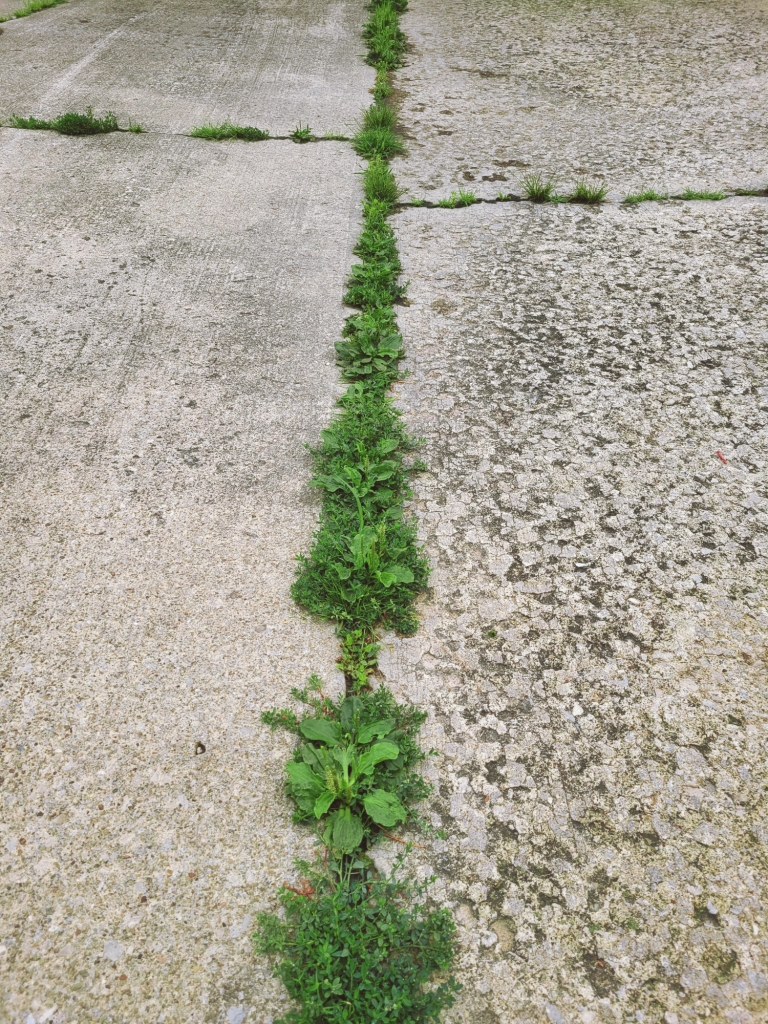Our driveway is crazed with cracks. I can’t help but appreciate plants springing up through these narrow possibilities. These are native plants, many with health-enhancing properties as human food, but also exquisitely cued to the lifecycles of crawling, flying, hopping creatures reliant on them. All these lifeforms follow nature’s essential precepts of diversity, adaptability, balance, and interdependence. Although our driveway does not, it’s heartening to see how easily life takes over.

I used to wonder about the soil under the sidewalk where I trudged to school each day. What happened when graders and rollers and cement trucks imprisoned it? Did all the life in that soil perish without sunlight and oxygen? How could any living thing survive so much pressure and heat? What would happen if we paved over too much of Earth’s surface? I was a child who Worried About Things.

These plants springing from cracked pavement remind me of nature’s beautiful impulse for life. It restores my hope everywhere I find it. A handful of dry lentils taken from my cupboard, after a few days of soaking and draining, grow into cheery little sprouts I can use in salads, or feed to the chickens, or plant to grow into another generation of lentils. Seeds brought from Cyprus decades ago, shared by a friend, grow each year into giant hardy winter squash that keeps well until late winter –providing nourishing meals along with more seeds to save and share. Organic potatoes in my pantry wrinkle around tiny rosettes and from them, pale tendrils fragile with new life reach out in search of sunlight. I plant these eyes two or three times each season, from late March to late August, for fresh harvests of tender heirloom potatoes.

Life’s impulse can’t always survive what we humans are doing to this planet. As a direct result of human activity, the rate of species extinction is up to 10,000 times higher than the natural, historical rate. Research published in the journal Proceedings of the National Academy of Sciences shows ocean heating is equivalent to between three and six 1.5 Hiroshima-size atomic bombs per second. The UN says “climate change is out of control” and experts in Earth’s climate history are convinced this current decade of warming is more extreme than any time since the last ice age, about 125,000 years ago. It’s exhausting to think about, let alone act on, this spiraling disaster.

We need new stories that reawaken us to the lived wisdom of this planet’s First Peoples and lead us to the most ethical, scientifically grounded regenerative lifeways going forward. It helps when we recognize nature isn’t just what sprouts from cracked pavement. It isn’t confined to wild places we long to visit. We are nature, right down to the life processes of every cell. It helps when our new stories speak to our descendants. It helps when they answer our ancestors.
HOPEFUL RESOURCES
books
Nurturing Our Humanity: How Domination and Partnership Shape Our Brains, Lives, and Future (indie link) Riane Eisler and Douglas P. Fry
Active Hope (revised): How to Face the Mess We’re in with Unexpected Resilience and Creative Power (indie link) Joanna Macy
Restoring the Kinship Worldview: Indigenous Voices Introduce 28 Precepts for Rebalancing Life on Planet Earth (indie link) by Wahinkpe Topa and Darcia Narvaez
The Evolved Nest: Nature’s Way of Raising Children and Creating Connected Communities (indie link) Darcia Narvaez and G.A. Bradshaw
Why the World Doesn’t End, Tales of Renewal in Times of Loss Michael Meade
We Are the Middle of Forever: Indigenous Voices from Turtle Island on the Changing Earth (indie link) by Dahr Jamail and Stand Rushworth
Breaking Together: A freedom-loving response to collapse Jem Bendell
Living Resistance: An Indigenous Vision for Seeking Wholeness Every Day (indie link) Kaitlin B. Curtice
Mystical Activism: Transforming A World In Crisis (indie link) by John C. Robinson
Local Voices, Local Choices: The Tacare Approach to Community-Led Conservation (indie link) by the Jane Goodall Institute
Becoming Kin: An Indigenous Call to Unforgetting the Past and Reimagining Our Future (indie link) Patty Krawec
organizations
I’d love to hear what books, organizations, and other resources can help us all reawaken to and bring about these new stories.


